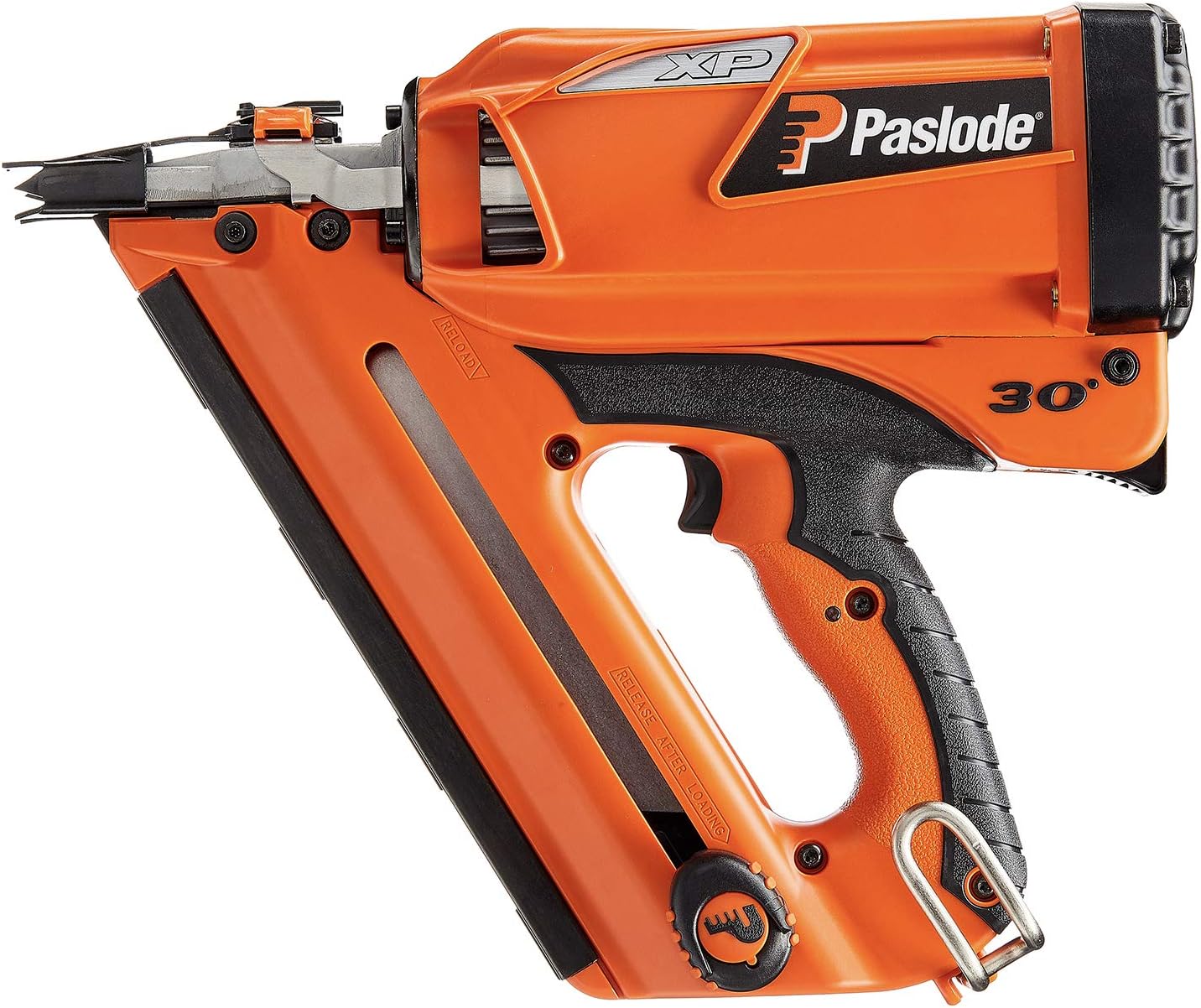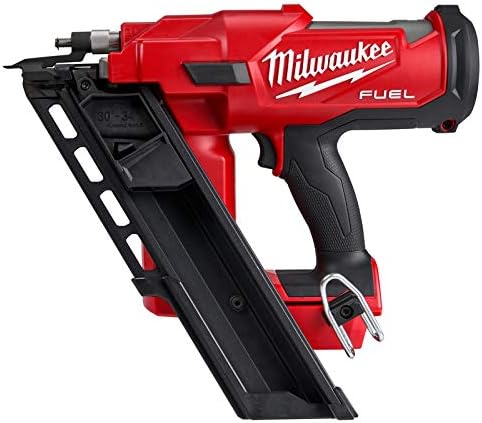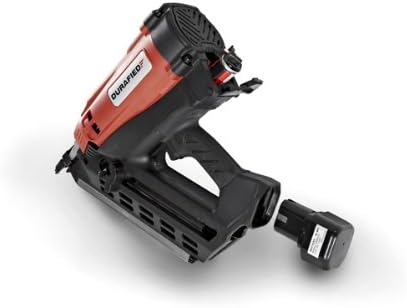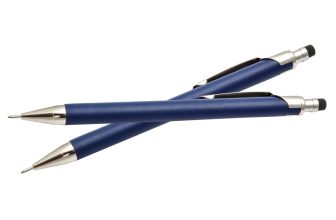Contents
Framing nailers are useful tools for construction and general woodworking projects, and cordless options make your work more convenient.
However, it’s not that easy to choose a cordless framing nailer. You need to decide between pneumatic and battery-powered nailers, and you’ll need to pick one that is lightweight enough for comfortable use and can provide enough power to drive large framing nails consistently.
We put together this list of reviews and a comprehensive buyer’s guide to help you navigate through the buying process and choose the framing nailer that is best suited for your projects.
Best Cordless Framing Nailers – Our Top Picks
BuildEazy.com may earn a commission if you purchase a product through one of our links.
BOSTITCH specializes in medium-to-high-grade tools designed for optimal performance for avid woodworkers.
This framing nailer is entirely cordless and is powered solely by a lithium-ion battery. The battery lasts for around 750 fired nails and will likely power through any long working session or project before you need to recharge it.
It weighs just 8.1 pounds, so it’s comfortable to hold, even for long periods. You won’t need to hook this nailer up to an air hose either, so it’s one of the most maneuverable and portable framing nailers we tested.
It can comfortably fire 3½-nails into studs, and it accepts both full-head and clipped-head nails, making it a versatile nailer perfect for most woodworking applications. It also features a tool-less depth adjustment, so you can set your depth based on the job at hand. The nails are fast and straightforward to reload as well with a quick-release, locking lever.
It has a stall release lever that allows you to clear jams quickly, but we didn’t experience many jams during use.
This nailer has a brushless motor that is more efficient and quieter than brushed motors [link to the section of Buyer’s Guide on Brushed vs. Brushless motors], and it’s likely to last longer than brushed options.
Paslode 905600 Cordless XP Framing Nailer
Paslode focuses exclusively on producing nail guns, so they make some of the best nailers available for a wide range of applications.
This cordless nailer uses a battery in combination with fuel cells to provide long-lasting power for up to 9,000 nails per battery charge. It includes a capable 7-volt, lithium-ion battery as well as a charger. However, you will need to purchase fuel cells separately, or you won’t be able to use this framing nailer. The fuel cells can handle up to 1,200 nails before needing replacement.
You won’t be tied down to a compressor, but you will need to purchase replacement fuel cells on an ongoing basis. These cells will add to the ongoing cost of using this nailer, and you’ll need to spend time replacing fuel cells as you use up the gas inside.
It weighs 7.2 pounds, so it’s on the lighter side and is effortless to maneuver and use for extended periods. It’s also top-heavy and relatively compact, and it puts little strain on your wrist as you’re nailing.
The battery and fuel cell provide ample power to shoot 3¼-inch nails consistently, and it can drive into hardwoods with relative ease.
Paslode made this nailer out of heavy-duty materials that feel like they will stand up to some serious job-site abuse.
DEWALT DCN692B 20V Max Cordless Framing Nailer
DEWALT creates power tools that are durable and powerful enough for just about any job, and this framing nailer stands up to that promise.
This nailer is powered entirely by a rechargeable battery, so there’s no need for fuel cells. You won’t be tied down or restricted when moving around your job site with this nailer, and so you can easily maneuver it around your project.
Keep in mind that you will need to purchase a battery and charger separately. However, you can use 20V batteries from other cordless DEWALT tools if you have them. A fully charged 20V DEWALT battery will drive around 500 nails, on average.
It weighs just 8 pounds and is compact enough to fit between studs and into tight areas when you’re working.
DEWALT fitted this tool with a capable, brushless motor for improved efficiency and durability. It can quickly fire 3½-inch nails through studs or hardwood, and it’s relatively quiet while doing so. The [brushless motor](link to buyer’s guide) also means the motor will be subject to less strain and will have a longer lifespan than brushed alternatives. The motor also offers two different speed settings to reduce motor strain and optimize for different fastener lengths.
It’s made of very heavy-duty materials and feels very solid in its construction. We have no doubt that this will stand up to years of use and abuse.
It gives you the option of sequential or bump firing, so it offers precision but is also ideal for making large projects much faster and for contractors who fire nails continuously.
Milwaukee M18 FUEL 30 Degree Framing Nailer
Woodworkers and contractors recognize Milwaukee’s tools as powerful and capable enough for most applications, and this framing nailer will definitely stand up to any professional’s test.
This nailer is powered predominantly by Milwaukee’s 18V REDLITHIUM batteries, so you won’t need to buy fuel cells. You can maneuver around your workspace with ease, but you will need to make sure you charge the battery.
It’s important to note that this nailer doesn’t come with a battery, so you will need to buy one separately. This additional purchase does add to the already relatively high price, but you can instead use batteries from other Milwaukee tools if you have them.
This nailer makes use of the unique Milwaukee FUEL system, so it has the power of a pneumatic nail gun with the convenience of a battery-powered one. It’s capable of driving 3½-inch nails into just about any wood you’re working with, including hardwoods and pressure-treated lumber.
It weighs just 8 pounds, so it’s lightweight enough to be easily maneuverable around your workspace, even for long periods or extensive jobs.
Milwaukee made this nailer out of heavy-duty plastic that feels like it will outlast quite a lot of use and abuse, and it includes rubber components on the handle for excellent grip to give you confidence while you work.
It allows you to adjust the firing depth for different types of wood. You can also choose between bump mode for rapid firing to save time or sequential firing to provide some accuracy.
Metabo HPT NR1890DRS Cordless Framing Nailer Kit
This cordless framing nailer from Metabo — formerly Hitachi — is powered by an 18V lithium-ion battery. It includes the required battery, a charger, and a carrying case, so you won’t need to make any additional purchases to start framing.
It weighs 10.1 pounds, so it may give you some difficulty maneuvering it if you’re using it for extended periods. However, it’s relatively compact and can fit between studs and rafters without any issues, and it’s also relatively comfortable to hold.
This nailer is made mostly of rigid plastic components that feel durable, so we’re confident that this will last for many years of use.
It has a brushless motor, so it’s a bit quieter than many other nailers. More importantly, the brushless setup reduces motor strain and makes the tool more efficient, so it will likely have a longer lifespan than brushed options.
Metabo uses similar air-drive technology to Milwaukee’s FUEL system, so there is no ramp-up before firing, and you also won’t need to buy new fuel cells for your nail gun continuously.
However, you’ll still enjoy the power of a pneumatic framing nailer with the portability of a battery-operated one. This nailer can fire 3½-inch nails into just about any material you’re working with, so it’s an excellent option for professional use or hobbyists who want ultimate versatility.
It gives you a choice between sequential firing and bump firing, so you can accurately place fasteners or move through large-scale framing projects quickly and efficiently.
Lastly, the driving system on this nail gun is very consistent, so you’ll spend more time getting your work done and less time re-shooting after a failed fire.
Durafied GFN Cordless Gas Framing Nailer
Durafied specializes in alternatives to pneumatic nail guns for professional use, which is exactly what you can expect from this nailer.
This nail gun is powered by a rechargeable battery, which works in conjunction with compressed gas to provide the power of a pneumatic nail gun. As such, you’ll need to purchase replacement gas cartridges as you go through them, which adds to the ongoing cost of using this tool.
However, you will have the convenience of purchasing most brand-name gas cartridges for use with this nailer.
This is a standalone framing nailer, so you won’t need to purchase or be tethered to a compressor or air hose during use. You can maneuver easily around your job site, especially since this nail gun weighs just 8.2 pounds. You shouldn’t have any difficulty getting it into tight spaces or using it for extended periods.
It features both bump firing for rapid framing and sequential firing to provide some accuracy if needed.
It’s powerful enough to drive 3½-inch nails into hardwoods or pressure-treated lumber. It also has a tool-less depth adjustment to set your tool for use on your specific job, so it’s a versatile gun that can handle a wide range of different projects.
The magazine has a 34-degree angle, which is uncommon for framing nailers. It will allow you to press the nailer’s nose into tighter corners and spaces than many other options.
The magazine can also hold up to 50 nails, so you’ll spend less time reloading your gun and more time powering through your framing job.
Durafied made this nailer out of durable metal materials and hard plastic components, so we’re confident that it will stand up to frequent use.
Lastly, it comes with a hardshell carrying case, a battery, and a charger, so you’ll have convenient, safe storage and a means for powering your tool continuously.
Buyer’s Guide
As you can see, there are numerous options to choose from, each with different power capabilities, movement limitations, and adjustability to set for different lumber types.
Focusing on the below factors will help guide you to the ideal tool for your situation and the projects you plan to complete with your framing nailer.
Corded Vs. Cordless
There are two types of framing nailers you’ll need to decide between: corded and cordless.
Corded nailers run entirely on compressed air, which means you’ll need to hook them up to an air hose and a compressor. Corded framing nailers don’t require you to recharge batteries or replace fuel cells, but you will need to hook them up to an air hose and air compressor.
They are less maneuverable because they require you to stay tethered to a compressor. Compressors need to be plugged into an outlet for power, so corded options aren’t ideal for remote job sites or those without power.
However, they usually provide the most power and are often less expensive than cordless options with similar quality.
Cordless framing nailers usually change a bit of power for convenience. Batteries often provide less driving force than compressed air, but they allow your nailer to be fully mobile and easily maneuverable. You can move around your workspace freely with a cordless nailer, and they’re typically easier to fit between and around studs and rafters since you don’t need to route the air hose through your workpiece as well.
Cordless nailers are excellent options for worksites without power. Since framing nailers are most often used to frame homes that don’t yet have electricity, they’re usually the option many contractors use for convenience.
Types of Wood You Plan to Use
It’s important to keep the types of projects you typically do or plan to do in mind when choosing a framing nailer. Not all framing nailers can drive into all kinds of wood, so the one you choose should be selected for your intended use.
There are two possible limitations that a nailer can have to prevent you from using all kinds of lumber: power and depth adjustment.
Many of the cheaper cordless framing nailers available have less powerful motors than premium ones. As such, they may have difficulty firing a 3½-inch [nail](link to nails) all the way into harder materials like pressure-treated lumber or hardwoods.
Nailers with more capable motors are often more versatile because you can use them on any kind of wood, but they often come at a higher price. Paying more for a nailer capable of heavy-duty use may not make sense if you only plan to work with softer woods or studs and joists that aren’t pressure-treated.
Additionally, heftier motors usually weigh more. Since you’ll be using your framing nailer one-handed most of the time, a tool that weighs in excess of 10 pounds may be unrealistic if you don’t need the extra weight that comes along with more power.
Depth adjustment can also prevent you from using your nailer with certain types of wood as well. Many framing nailers allow you to adjust how far or how hard your gun fires nails. A lower setting is often suitable for softer woods, whereas a high setting is ideal for driving all the way into harder woods.
Some nailers don’t have the ability to adjust depth, so you can only drive nails properly into the wood type for which they’re made. For example, you may find that a nailer without a depth adjustment fires too far into softwoods if it’s made for use with pressure-treated lumber.
If you plan to use your nailer on a specific kind of wood, choosing a nailer made for that wood and without a depth adjustment option may suit you perfectly. A slightly more expensive gun with better adjustment options will be more versatile should you need to use it with different materials in the future.
Durability
Most people use framing nailers on construction sites, which puts them at risk for heavy wear and tear. A durable nailer will be far more reliable in harsh conditions and is more likely to last longer than cheaper options.
Most manufacturers achieve durability by incorporating metal or heavy-duty plastic components into the construction of a framing nailer. These materials are more expensive to produce, which means a heartier nailer will likely cost you more than one designed for light-duty jobs or infrequent use.
If you’re someone who regularly uses your nailer, you may want to opt for one made of metal or hard plastic components to ensure a long lifespan.
However, heavy-duty materials typically weigh more than lighter-duty plastic, and a heavier nailer will be more challenging to maneuver around your workspace with one hand. You’ll need to balance durability with price and weight to find the best fit.
Price
The price of cordless framing nail guns can vary quite a bit depending on a few different factors that may play a role in your decision.
First, the quality of the construction materials will influence the cost. Metal, hard plastic, and high-quality rubber cost more to produce and will drive up the price of more durable guns. Lower-quality materials generally cost less but don’t last as long and may need to be replaced sooner.
The type of firing action also plays a role in your framing nailer’s price. A battery-operated nailer will often be cheaper upfront than one that uses replaceable or permanent fuel cells. The ongoing cost of disposable fuel cells will add to the price of some nail guns, like the Paslode 905600 Cordless XP Framing Nailer.
Permanent fuel cell nail guns tend to be more expensive than other options but are more energy-efficient and don’t require ongoing purchases.
Power Source
There are three options for the power source for cordless nailers: battery, battery and disposable fuel cell, and battery and permanent fuel cell.
Battery-only nailers use just a battery to fire. They’re often the weakest of the three but can still create enough power for most framing applications. They require the most frequent recharging and use the most electricity to recharge.
Framing nailers that run on a battery and a disposable fuel cell typically provide the same driving power that pneumatic nailers can achieve, but they require less frequent battery charges. However, you do need to replace the fuel cell, which adds to downtime and the ongoing cost of using the tool.
Lastly, nail guns that run on a battery and include a permanent fuel cell use a spark created by the battery to ignite and expand compressed gas trapped within the cell. The expansion causes the gun to fire instantly, often with the same force created by pneumatic options. These are the most expensive of the three but have a low ongoing cost.
Trigger Size and Firing Modes
The size of the trigger on your framing nailer can significantly affect your experience using the tool. A large trigger can make rapid firing very comfortable and effortless but can lead to lower precision in single-fire mode. A small trigger provides greater accuracy but can be less comfortable to hold down for firing in quick succession.
Many framing nailers come with two different firing modes that make them more versatile and comfortable to use: sequential firing and bump firing.
Sequential firing only fires when you pull the trigger with the safety tip compressed. The gun will fire a single nail each time you pull and release the trigger. It offers precision when you need it, but it can inhibit speedy work and tire out your hand quickly.
When set to bump firing, the gun is ready to fire when you pull and hold the trigger but won’t drive a nail until the safety tip is compressed. It allows you to hold the trigger comfortably and simply bump the gun against the work surface to fire nails. Rapid firing and faster work are possible with bump mode.
Some cheaper guns lack the capability to perform bump firing, so make sure you choose a gun with the option if you want both precision and speed capabilities.
Adjustable Nail Depth
Many modern framing nailers include an option to set the nail depth, which is really an adjustment of firing power.
Lower firepower is ideal for softer woods that you’ll commonly encounter in framing applications for homes. However, most guns won’t fire nails all the way into hardwoods or pressure-treated lumber on a low setting.
Higher firepower is suitable for driving into harder materials, but it may shoot nails too deeply into softer woods.
Choose a gun suited for the material you intend to work with or opt for a slightly more expensive gun that gives you the ability to adjust nail depth.
Magazine Capacity
All cordless framing nailers include a magazine for holding nails in place to drive, but the capacity varies from one nail gun to another. A larger capacity means that you’ll spend less time reloading your gun and more time getting your work done.
Nailers like the BOSTITCH BCF30P1 Framing Nailer can hold over 50 nails at once, while others have much smaller capacities closer to 30 nails.
Larger jobs are made significantly faster and more efficient with more prominent nail magazines, but larger components will also add to your tool’s weight.
Brushless Vs. Brushed
Electric nail guns that are battery-powered use either brushless or brushed motors.
Brushed motors transmit electrical signals to the motor’s spinning part via metal brushes that make physical contact with the rotor. The resulting friction puts added strain on the motor, ultimately making it less efficient and leading to faster degradation and decreased lifespan.
Brushless motors send electrical impulses over a gap, eliminating added friction on the motor. The result is a more efficient tool that is often quieter during use and has more longevity from decreased stress.
Brushless motors are more expensive to produce, so they will cost you more. However, the higher price may be worth it for you if you plan to use your tool often and need the most durable nail gun possible.
Clearing Jams
Your cordless framing nail gun is bound to jam from time to time, so you need to consider how you’ll be able to clear jams in a nailer before deciding on which to purchase.
Some cheaper nail gun options have jam-clearing mechanisms that require tools. A tool-less clearing option is much more convenient and will take less time away from your work. However, tool-less mechanisms are usually more expensive.
Design and Ergonomics
The design and comfort of the nailer you choose will affect your experience using it but will also determine which working applications it can be useful for.
You’ll maneuver and use your framing nailer with one hand, so you should carefully consider what kind of impact the weight and comfort will have on your work. A heavy nailer with a thick handle can be unwieldy and challenging to maneuver around studs and rafters while you work. Conversely, a comfortable handle and lightweight design can make moving around your workspace effortless.
You’ll also usually use your nailer between studs and occasionally to toenail pieces of lumber in place. A slim gun design can make situating your tool between studs simple, and a 30-degree nail magazine will allow for an adequate angle of attack while toenailing studs in place.
Features and Extras
Cordless framing nailers can come as individual tools, but many include extras that make your work or traveling with your tool easier.
For example, the Durafied GFN Cordless Gas Framing Nailer includes a hardshell carrying case to protect your tool when traveling or when it’s not in use. The durable case can extend your tool’s lifespan and make transporting it from job site to job site a breeze.
The BOSTITCH 20V MAX Framing Nailer Kit offers even more perks. It includes the tool, a rechargeable 20V battery, a battery charger, and a soft bag to transport or store the tool and the extras.
Additional features and extras aren’t a requirement, but they can add to your tool’s value and improve your experience using it.
Warranty
Some cordless framing nailers include a warranty to cover damage or required service on your tool within a given timeframe. A warrant can cover anything from failed components to physical damage, and it can last for several years or the lifetime of the tool.
A warranty isn’t a requirement on a cordless framing nailer, but it does help instill confidence in the tool you’re purchasing. It shows that the manufacturer stands behind their product and guarantees that it will stand up to the work for which it’s intended.
Wrapping Up: Which Cordless Framing Nailer is Best?
Choosing the best cordless framing nailer requires a lot of thought and consideration because different options are ideal for different applications. You’ll need to consider how you plan on using your tool, the frequency with which you’ll use it, and the materials you plan to work with most often.
Although no nailer is ideal for everyone’s needs, our top pick for quality, convenience, and durability is the BOSTITCH BCF30P1 20V Framing Nailer Kit. It includes everything you need aside from nails to get started, it requires no ongoing purchases to use, and it’s powerful, capable, and maneuverable enough to handle just about any framing application with ease and comfort.
Frequently Asked Questions
What Is The Difference Between A Framing Nailer And A Finish Nailer?
A framing nailer is a type of nail gun primarily used for larger DIY and construction projects. Framing nailers are used for tougher and thicker pieces of wood or other materials, such as 2x4s and decking.
They use large 8-gauge nails, typically 16d or 10d (3.5 inches and 3 inches respectively), and have enough power to drive them through thick and hard materials.
One of the main benefits of framing nailers is their speed. While nailing manually is tiring and time-consuming, a framing nailer is able to drive several nails in the time it would take to hammer a single nail by hand, and requires minimum effort to use.
A finish nailer, on the other hand, is a smaller nail gun that is used for more precise, delicate purposes. They can’t accommodate the larger nails required for heavy-duty building materials such as fences and 2x4s, instead using 16- or 15-gauge nails approximately 1-2 inches in length.
Because of their comparatively weaker strength and smaller nail size, finish nailers won’t be able to be used for the same purposes as framing nailers.
Instead, they are most useful for small-scale DIY projects, such as securing baseboards and other trims, securing cabinets, and even for building furniture.
The main differences between framing nailers and finish nailers are their purposes and (as a result) the size and type of nails that they use. Both types of nail guns are incredibly useful and effective at their intended purpose, but they won’t be as good if you try to swap them out.
For example, a finish nailer won’t have the strength or the capacity for the large 3.5-inch nails required for heavy-duty construction work. Similarly, a framing nailer won’t have the precision necessary for more delicate jobs such as securing baseboards or window trim.
Why Do Framing Nailers Have Different Degrees?
The degree of a framing nailer isn’t the angle at which the nail is driven. Instead, the degree refers to the collation of the nails – the method and angle of how the nails are stored within the nail gun.
Different degrees use different forms of collation, and the degree of a nail gun means it can be used for different purposes.
Framing nailers have different degrees to help them perform better at different functions. Low-degree framing nailers (such as 15-degree nailers) use wire-coil collating to keep them together.
This makes it easier for the framing nailer to access hard-to-reach areas such as tight corners and wall studs. It also means that the nails won’t separate in wet or humid areas, so it is perfect for use outdoors in wet weather.
High-degree framing nailers, typically between 30-34 degrees, are even better at reaching tight spaces at tricky angles. They also tend to do away with wire-collated nails in lieu of plastic or paper strip collation.
In addition to the extra maneuverability offered by these degrees of framing nailer, the collation makes the nails cheaper to buy and easier to use than wire-coil collated nails.
Can I Use A Framing Nailer For Fence Pickets?
A framing nailer is the ideal type of nail gun for all varieties of fence. Because they use long nails, framing nailers are capable of creating secure and durable fences in no time at all.
Using a framing nailer for fence pickets will greatly reduce the time and effort it would take to construct a fence manually. With their effectiveness and efficiency at driving nails through stronger building materials, framing nailers get your fence built without needing to spend hours on end hammering away.
You can theoretically use a finish nailer for fence pickets, but it is ill-advised. The shorter and thinner nails they use are less effective at securing the fence posts, and are more prone to snaps and breaks.
Thicker fences won’t be secured at all, as the nails won’t be able to drive all the way through the materials.
When you’re building a fence, a framing nailer is the best choice.













